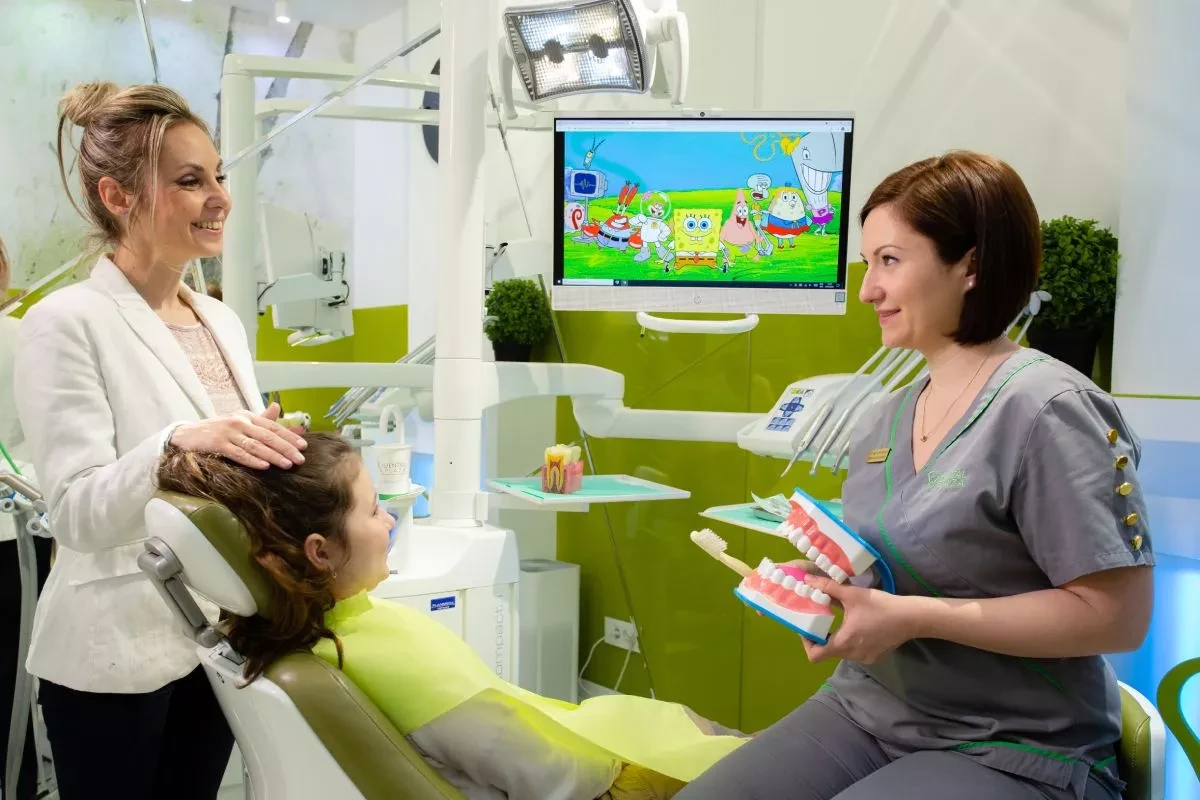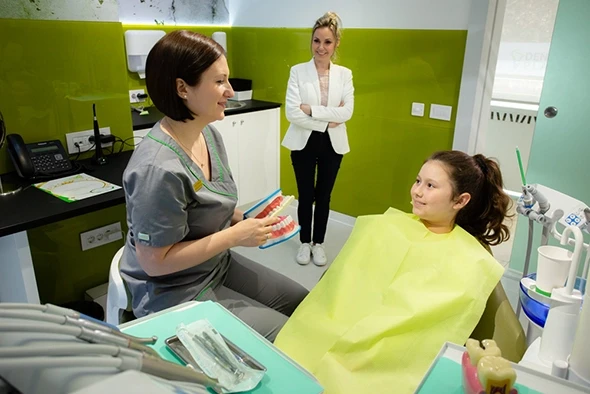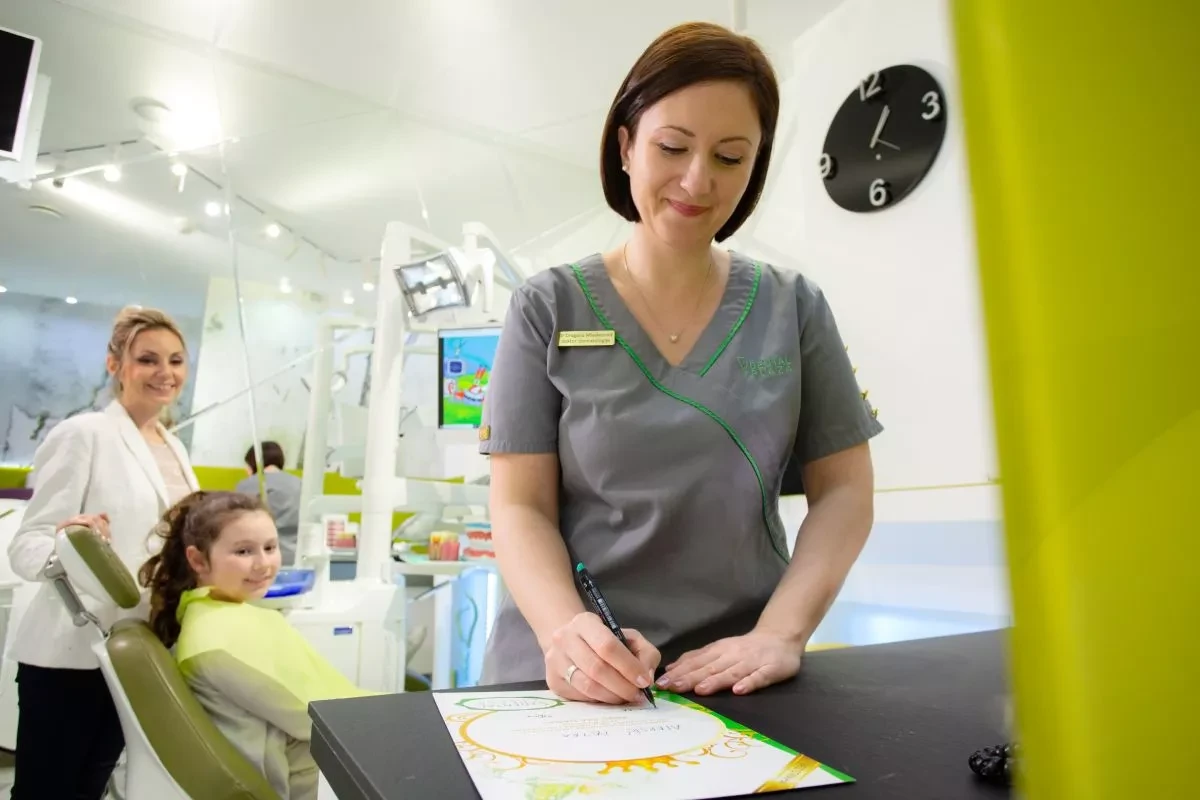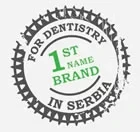Do not be shy, show your teeth!
Call Center 08-21h
Do not be shy, show your teeth!
Call Center 08-21h

This procedure is a simple teeth cleaning. It is painless and very suitable for children to get used to the sound of dental instruments, and at the same time to clean their teeth from dental plaque. It is best to use appropriate dental plaque detection tablets before starting. These tablets contain pigments that discolor dental plaque, so that it is noticeable and visually displayed to children. Brushes and abrasive pastes are used to remove plaque. In this way, children accept further procedures more easily.
Soft deposits are plaques on the teeth that are formed every day. Soft deposits or dental plaque are formed every day after eating food and remain on the teeth if they are not mechanically removed with a brush.
When the soft deposits remain longer on the teeth, their calcification begins with minerals from the saliva and a hard deposit is formed – tartar. Tartar is usually deposited at the junction of the tooth and the gingiva, but it can be found on all surfaces of the tooth. In the beginning, it is white in color and over time it becomes a deposit of dark yellow color.
Soft deposits are removed by regular dental hygiene, while hard deposits are removed in the dental clinic. The intervention is carried out with ultrasound machines with obligatory polishing of the teeth.
When it comes to dental plaque, i.e. its removal, the procedure is very simple and takes about 10-15 minutes. Rotating brushes and abrasive pastes are used to remove soft deposits. With this, the teeth are completely cleaned of soft deposits.
Surely. The procedure for removing soft deposits is also performed after ultrasonic stone removal in adult patients.

Fissure filling is a procedure in which composites of a special composition are applied to the deep spaces on the biting surfaces of the teeth. This prevents retention of food and prevents the occurrence of caries on the lateral teeth. It is recommended that this measure be done at the age of six, immediately after the eruption of the permanent molars (cheek teeth).
Small children can still be fluoridated. With this procedure, high-concentration fluorides are applied directly to the surface of the teeth, which promote tooth remineralization. Locally applied fluorides can prevent the formation of carious lesions or prevent the further development of initial caries. Also, if there is too much sensitivity of the teeth to various stimuli due to thinned enamel, applying remineralization agents creates a protective layer that will prevent unpleasant sensations.
Removing soft deposits is a completely simple and painless method and takes about fifteen minutes. There is no need for anesthesia for this intervention.
During the removal of soft deposits, pigmentation caused by coffee, cigarettes and dark teas is also removed. With this, the teeth will look more beautiful and without dark spots, but it is important to emphasize that this procedure cannot achieve the same effects as after teeth whitening when the means intended for this are used.
Every three months, it is necessary to bring children for check-ups, in order to check the condition and to preserve their oral health. Children's dentistry tries to create healthy habits for children, so you should not forget about visits to the dentist.

Soft deposits are deposited on the teeth due to poor oral hygiene. With proper technique and with emphasis on regular tooth brushing, poor hygiene and unwanted food retention are prevented in children. When it comes to brushing children's teeth, it is very important to start as soon as with the appearance of the first milk tooth. Until the second year, it is sufficient to wash it with a brush and water, unless the dentist judges that it is necessary to include the paste as well. As a rule, a once-acquired habit remains throughout life, so it is important to teach children how to brush their teeth properly.
It is easiest to explain to them the washing system "how the rain falls and how the grass grows", because brushing children's teeth is best associated with games and songs so that they will love this activity. The most important thing is to remove all the remains of food and deposits that remain near the gums and in the deepest parts of the teeth, i.e. dimples and fissures. Children's dentistry is an important branch of dentistry, and the Dental Plaza team will do everything to make your child's visit to the dentist a pleasant experience.

Do you have questions?

This procedure is a simple teeth cleaning. It is painless and very suitable for children to get used to the sound of dental instruments, and at the same time to clean their teeth from dental plaque. It is best to use appropriate dental plaque detection tablets before starting. These tablets contain pigments that discolor dental plaque, so that it is noticeable and visually displayed to children. Brushes and abrasive pastes are used to remove plaque. In this way, children accept further procedures more easily.
Soft deposits are plaques on the teeth that are formed every day. Soft deposits or dental plaque are formed every day after eating food and remain on the teeth if they are not mechanically removed with a brush.
When the soft deposits remain longer on the teeth, their calcification begins with minerals from the saliva and a hard deposit is formed – tartar. Tartar is usually deposited at the junction of the tooth and the gingiva, but it can be found on all surfaces of the tooth. In the beginning, it is white in color and over time it becomes a deposit of dark yellow color.
Soft deposits are removed by regular dental hygiene, while hard deposits are removed in the dental clinic. The intervention is carried out with ultrasound machines with obligatory polishing of the teeth.
When it comes to dental plaque, i.e. its removal, the procedure is very simple and takes about 10-15 minutes. Rotating brushes and abrasive pastes are used to remove soft deposits. With this, the teeth are completely cleaned of soft deposits.
Surely. The procedure for removing soft deposits is also performed after ultrasonic stone removal in adult patients.

Fissure filling is a procedure in which composites of a special composition are applied to the deep spaces on the biting surfaces of the teeth. This prevents retention of food and prevents the occurrence of caries on the lateral teeth. It is recommended that this measure be done at the age of six, immediately after the eruption of the permanent molars (cheek teeth).
Small children can still be fluoridated. With this procedure, high-concentration fluorides are applied directly to the surface of the teeth, which promote tooth remineralization. Locally applied fluorides can prevent the formation of carious lesions or prevent the further development of initial caries. Also, if there is too much sensitivity of the teeth to various stimuli due to thinned enamel, applying remineralization agents creates a protective layer that will prevent unpleasant sensations.
Removing soft deposits is a completely simple and painless method and takes about fifteen minutes. There is no need for anesthesia for this intervention.
During the removal of soft deposits, pigmentation caused by coffee, cigarettes and dark teas is also removed. With this, the teeth will look more beautiful and without dark spots, but it is important to emphasize that this procedure cannot achieve the same effects as after teeth whitening when the means intended for this are used.
Every three months, it is necessary to bring children for check-ups, in order to check the condition and to preserve their oral health. Children's dentistry tries to create healthy habits for children, so you should not forget about visits to the dentist.

Soft deposits are deposited on the teeth due to poor oral hygiene. With proper technique and with emphasis on regular tooth brushing, poor hygiene and unwanted food retention are prevented in children. When it comes to brushing children's teeth, it is very important to start as soon as with the appearance of the first milk tooth. Until the second year, it is sufficient to wash it with a brush and water, unless the dentist judges that it is necessary to include the paste as well. As a rule, a once-acquired habit remains throughout life, so it is important to teach children how to brush their teeth properly.
It is easiest to explain to them the washing system "how the rain falls and how the grass grows", because brushing children's teeth is best associated with games and songs so that they will love this activity. The most important thing is to remove all the remains of food and deposits that remain near the gums and in the deepest parts of the teeth, i.e. dimples and fissures. Children's dentistry is an important branch of dentistry, and the Dental Plaza team will do everything to make your child's visit to the dentist a pleasant experience.
